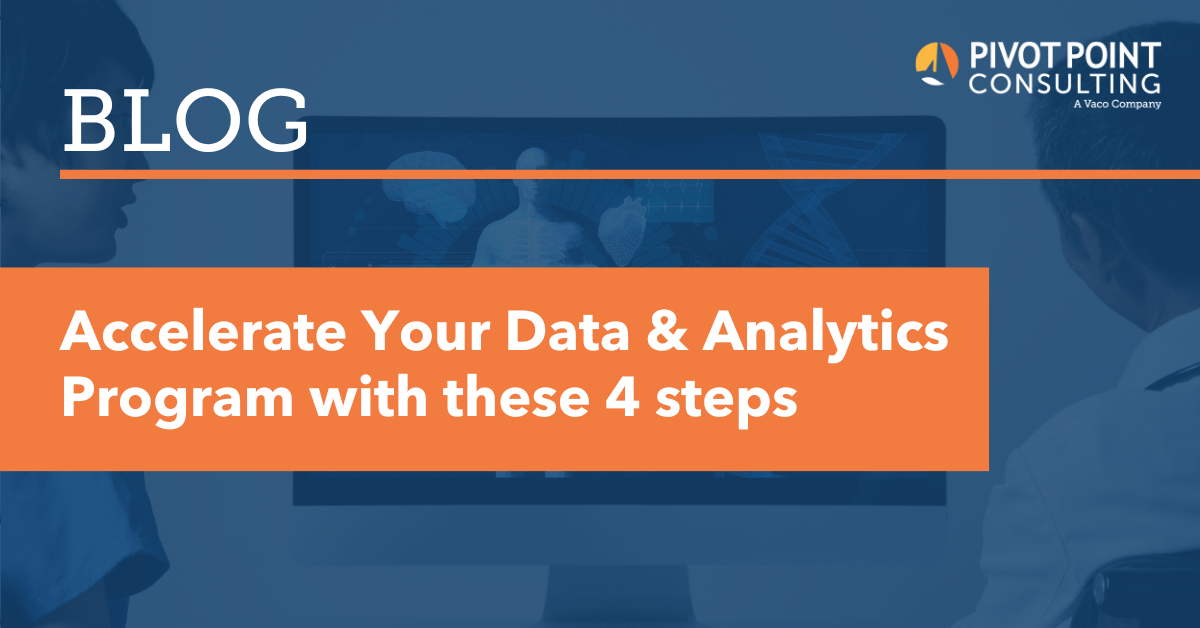Healthcare is notoriously slow to adopt technologies. This industry, after all, still uses fax machines to transmit important patient information. In some form, we’ve all heard statements like this a lot over the years. I find this to be overly critical. Sometimes, I want the adoption of technology to be slow – especially if it is related to a new surgical procedure, a device used to keep me alive, or something that will be implanted into my body. “New” can mean speculative or unvetted. At the same time, I do appreciate the sentiment. There is more that we can do to move faster in healthcare IT. We often blame regulatory requirements and the protection of patient privacy. There can be no compromise on these requirements. That said, we can support this and move much, much faster with higher quality. This requires thinking like an entrepreneur and operating like a startup. Here are four suggestions to accelerate your analytics journey.
Think BIG and start small
One of the most significant barriers to adoption for hospitals, medical groups and private practices is the perceived cost of technology. No wonder, given the dubious advice being dispensed by many IT consulting firms and “thought leaders” urging healthcare organizations to invest millions in emerging analytics and AI technologies. The “go big or go home” mentality is counterproductive and likely to result in healthcare organizations continuing to avoid investments or – even worse – plunging ahead without a cohesive strategy or a set of best practices to ensure ongoing success and scalability of their program. Make no mistake: An effective analytics program is indispensable to healthcare organizations pursuing value-based care (VBC) goals such as improving patient and population outcomes while increasing efficiency and lowering costs. An analytics program will also be expensive over time. However, the value will far outpace the cost if done right. A far better strategy for healthcare organizations that want to leverage analytics and AI is an incremental approach that doesn’t necessitate a heavy upfront investment and allows organizations to demonstrate value incrementally and often – increasing the investment as the value is demonstrated. Thinking BIG and starting small with an analytics program gives development teams time to smooth out any rough edges before moving beyond the pilot phase. Further, internal consumers of analytics and AI may not even know at first what they need. There’s a saying in analytics: “Give me what I’m asking for so I can tell you what I really need.” Much as website designers will give clients something to react to so they can iterate improvements, data scientists and data analysts should seek actionable feedback from data analytics consumers.
Fund teams like an investor
The most dynamic startups prioritize innovation and iteration. They also have a laser like focus on providing genuine value. Large healthcare organizations, in contrast, can be mired in bureaucracy and process, diminishing their ability to be agile and innovate. That’s why healthcare organizations should invest in their analytics teams as startups. This includes providing initial and ongoing funding as the initiative demonstrates business value. Conversely, should an analytics team fail to show value or meet agreed-upon performance goals, organizations would be wise to cut their losses, take time to learn from the experience and allocate those resources elsewhere. Such a market approach encourages rapid innovation and minimizes the cost on failed projects, benefiting healthcare organizations.
Form multidisciplinary teams
Nothing kills innovation faster than rigid internal structures and siloed thinking. Historically, business and technology have been treated as separate entities in healthcare. Digital native companies such as online startups, however, make no such distinctions, enabling them to accelerate product development and foster collaboration. To optimize the chances of their analytics pilot succeeding (and being replicated), healthcare organizations must ensure their analytics teams are a shared resource between business, clinical and technology.
Motivate intrinsically
Healthcare systems tend to rely on the traditional “carrot and stick” approach in which employees are rewarded for doing things “right” and punished for doing things “wrong.” This is a common approach to leadership across industries introduced in the early days of the industrial revolution and reinforced over many decades. To foster innovation, what’s needed instead is an environment that 1) motivates people based on purpose, 2) offers them autonomy, and 3) provides an opportunity to develop mastery. Edward Deci and Richard Ryan introduced this idea in the ’70s as Self-Determination Theory (SDT). Daniel Pink later popularized this in the 90s in his book Drive. Exemplars of this approach to leadership are Lockheed Martin’s Skunk Works, responsible for the SR-71, U-2 and stealth technology, and more recently Netflix and Google. To make this work, it is about promoting decision-making where the work is done. This means leading by intent and context, and not directives. It means promoting a work environment where failures are not punished but seen as part of the learning process as teams iterate at a blazing pace. The faster they can apply their lessons learned, the faster they innovate and succeed. It also means data innovation happens more broadly across the organization instead of resting with a few leaders or committees. “If you want your team to innovate,” advises Harvard Business Review, “you need to create a culture of intellectual bravery in which team members are willing to disagree, dissent, or challenge the status quo.” Whether you call it intellectual bravery or “freedom to fail,” a healthcare organization’s data analytics team must be encouraged to take chances and make mistakes.
Putting the Steps Together
Large-scale investments in analytics programs are risky and can drain healthcare organizations of money and resources without paying off. To accelerate your analytics program and invest wisely, it is helpful to think like an entrepreneur and operate like a startup. Have BIG aspirations yet deliver incrementally and often, demonstrating value along the way. Power this process by funding delivery teams like an investor, forming teams that are multidisciplinary, and leading these teams by motivating them intrinsically.


